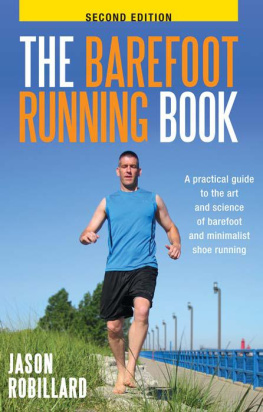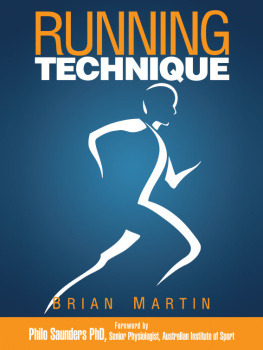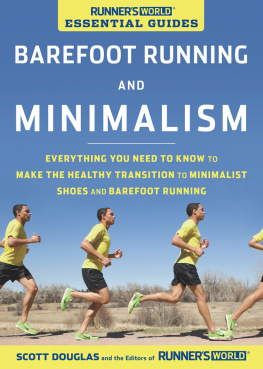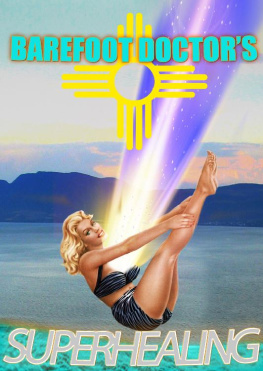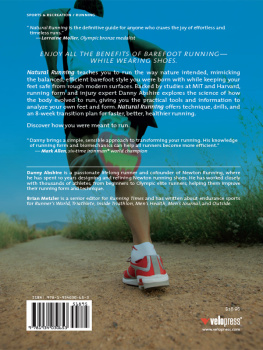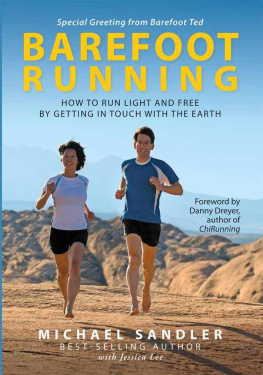SECOND EDITION
THE BAREFOOT
RUNNING BOOK
A practical guide to the art and science
of barefoot and minimalist shoe running
JASON ROBILLARD
Barefoot Running Press
Allendale, Michigan
The Barefoot Running Book
A practical guide to the art and science of barefoot and minimalist shoe running Second Edition
Copyright 2010 by Jason Robillard
All Rights Reserved.
No part of this book may be reproduced in any form or by any electronic or mechanical means including information storage and retrieval systems, without permission in writing from the author. The only exception is by a reviewer, who may quote short excerpts in a review.
Library of Congress Control Number: 2010907773
ISBN 978-0-615-37688-2
Printed in The United States of America
First Printing: March 2010
Barefoot Running University
9071 Willow Creek Lane
Allendale, MI 49401
http://barefootrunninguniversity.com
Contents
Preface
The journey started with a crushed dream. It was a hot, sticky day in late July, 2005. I was lying in a ditch surrounded by dried mud. Tiny gnats floated above my head and bristle-like grass poked at my skin. The sensation of lying there provided a brief reprieve from the pain shooting through my legs. Try as I might, I could not muster the strength to climb back to the road.
While lying there, blankly staring at the wispy clouds above, I was forced to accept the fact that my dream of running a 50-mile ultra-marathon was going to remain just thata dream.
Five months earlier, while training for what would be the toughest physical goal I ever attempted, I was foolishly over-confident in my abilities. Why not? I had faced adversity before believing hard work coupled with unwavering determination would make it happen.
But I was wrong. My body simply could not take the beating. I had developed plantar fasciitis resulting in me hobbling out of bed each morning. Every step was met with a searing pain that took hours to extinguish. I had also developed shin splints which made me feel as if my lower legs would snap at any moment. To make matters even worse, I developed what felt like a fractured pelvis and my kneecaps hurt so much I had to walk backwards down stairs.
Through all of that I persevered and trained when I could, sometimes missing days at a time in a feeble attempt to heal my broken body. One day while attempting to keep to my training schedule of running 30 miles, I was at the 12-mile mark when two semis passed one another. In an attempt avoid them I accidentally stepped on loose gravel at the edge of a steep ditch. Most people would have simply adjusted their weight but in my broken-down state, the best I could muster was to frantically wave my arms. With my barely-functional legs I could not respond fast enough and ended up tumbling down the embankment.
Oddly, the fall did not hurt as much as the pain from running. At that moment I realized there was no way I would ever be an ultrarunner. The best I could hope for was suffering through a marathon.
After dragging myself out of that ditch I took a few days off before easing back into training. A month later I ran a marathon. But it wasnt the fifty miler I had dreamed of because the race, while fun, felt more like failure than a victory.
Later that winter I began to research better training methods. I was looking for an answer, any answer, in order to finish that same 50-miler the following year. My research led me down many paths from low heart rate training to Gallowalking. I researched low mileage and high mileage training, advances in shoe technologies, custom orthotics, and various braces and devices runners use to support their various ailments.
One day I stumbled across an obscure article in an academic journal where an author was making a case for barefoot running. The hypothesis was simple: running without shoes strengthens your feet and forces you to run with good form. It was an intriguing idea and ran polar opposite to every bit of information I had researched. For me, the selling point was simpleI used to run barefoot.
My first attempts at barefoot running occurred way back in 1992 while preparing for high school wrestling.
At the time I was running with a good friend of mine, Jason Saint Amour. We had the idea of running barefoot on asphalt to toughen our feet. And, in my first experience with minimalist shoes, we would routinely run in wrestling shoes. At the time our friends thought we were crazy. Who knew at the time we were just a couple of early adopters!
Over the next 13 years, I was a sporadic recreational runner. My goals were to keep fit while attempting to maintain a reasonable weight. All the while my waistline was slowly expanding due to my love of beer, bacon, and gas station hot dogs.
Then in 2004, I met my wife Shelly who introduced me to the concept of regular exercise including several weekly runs totaling 1015 miles. Though I had always enjoyed running, it wasnt until then that I began taking it seriously. During those runs I always wore shoes. It was early in our relationship and I didnt want to reveal my past interest in barefoot running just yet.
Because I was now a semi-serious runner, I felt I needed formal running shoes. A local big-box sporting goods store advertised a major shoe sale. When I arrived, a teenage salesperson named Duane helped me by measuring my feet and giving me a few suggestions. I tried on a few pairs, parading back and forth in front of Shelly and Duane. Two pairs were especially comfortable; the padding in both made it feel as if I were walking on marshmallows. It seemed like a good decision. I had what I thought were comfortable running shoes and was now ready to run in a race.
That next year, in 2005, we decided to run a 15K road race. Even though running in shoes over longer distances felt strange, I adapted the same technique I saw other runners using. They would land on their heel and roll their foot forward. For me it still felt awkward, but seemed to work. Even though that particular race was fun and went well, I did lose several toe nails and did experience pain. Undeterred, the following day I committed to a 50-mile race.
The rest of that summer I obsessively worked toward my ultimate goal of successfully running a 50-miler. Unfortunately my body did not cooperate and injuries started piling up. As a result I started skipping one workout a week and relying on ice baths to ease the pain after every run.
As a quick sidebarice baths that involve submerging anything above the thighs should be classified as torture. There are certain parts of our anatomy that were not designed to be submerged in 40 water.
A friend who noticed the pain I was experiencing suggested I go to a local specialty running store for new shoes. Apparently Duane, from the big box retail store, wasnt the expert I assumed. At the running store the salesperson seemed to be more knowledgeable. He had me dip my feet in water and stand on a piece of paper to measure my arches. Apparently they were normal.
Then he had me walk on a treadmill (barefoot, mind you). He used a term I was vaguely familiar with: pronation. I was a mild overpronator. He gave me what he described as the perfect pair of shoes. When I explained my experience with Duane we shared a good chuckle about my naivety. Duane clearly did not have the shoe fitting expertise the running store could provide.
I went home and resumed training, confident my new professionally-fitted shoes would eliminate my debilitating injuries. I was wrong. The pain multiplied.
Everything culminated on that fateful day when I plunged into the ditch. It was my low point, both literally and figuratively. I never forgot the feeling of complete and total failure, the stabbing pain of defeat, the emptiness of hopelessness. I felt I wasnt capable of

